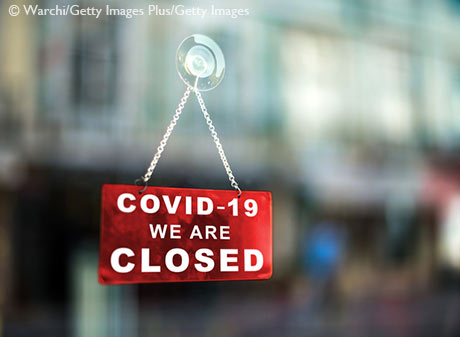How Closing Restaurants and Hotels Spills Over to Total Employment

This post has been revised and corrected to reflect helpful comments by Richard Graham, a senior economist at the Bureau of Labor Statistics.
The social distancing policies being used to slow the spread of COVID-19 are having direct negative effects on the accommodation and food services industries due to their contact-intensive nature. A recent blog post assigned an index value to each occupation describing the degree to which workers needed to complete their job’s tasks in close physical proximity to others. On that scale, food and beverage workers tended to work with one another at an arm’s length distance away. Data provided by opentable.com from the nearly 60,000 restaurants that use their platform for table reservations indicate that restaurants are facing serious challenges to remain open. These data are freely available and updated daily at the reservation network’s webpage, “The state of the restaurant industry.”
On March 1, the number of diners seated in restaurants was up 2% relative to the same day last year. Since then, however, the number of seated diners has steadily declined as cities and states began imposing restrictions. Diners seated in restaurants had declined over 50% by March 16, and essentially all restaurants in the OpenTable network had stopped seating diners altogether by March 21. Something similar has occurred in the hotel industry, with some states restricting lodging to residents and nonresidents travelling for business, but not allowing nonresidents to stay (e.g., Utah).
Ripple Effects through Local Businesses
Reducing the scale of operations in the accommodation and food services industries not only reduces their employment, but also indirectly affects the employment of other sectors that provide them with goods and services.
For example, if a hotel contracts with a transportation service to shuttle guests from the airport, a reduction in business for the hotel also means a reduction in business for the shuttle service. This lack of business may, in turn, keep the transportation service from making repairs to its vehicles. Thus, it can also be said that the hotel’s losses contributed to losses for local vehicle repair companies.
The Bureau of Labor Statistics publishes input-output tables which trace the full effect of a loss in employment in one sector to employment losses in all other sectors. By its estimate, for every 10 workers that lose their jobs due to declining sales here and throughout the rest of the text, “sales” is measured as sales to final users of a good or service as opposed to other industries. It is measured by “Final Demand” in the 2018 BLS input-output tables. in restaurants and bars, an additional 3.11 workers lose their job elsewhere in the economy. If declining sales remove 10 workers in the hotel industry, by contrast, a full 8.19 workers will lose their jobs elsewhere.
The food services and accommodation sectors produce 4.3% of all sales and employ 8.8% of the total employment. This implies that a partial shutdown of hotels, restaurants and bars due to social distancing is going to have important spillover effects for employment in the rest of the economy. For reference, the construction sector accounts for 5% of value-added and total employment, but also has important spillovers to the rest of the economy. For example, the 2013 working paper “Reconstructing the Great Recession” calculated that the decline in construction activity during the last recession accounted for between 25% and 50% of the drop in total employment and value-added.
Effects of a Decline in Accommodation and Food Service Sales
According to our calculations, a 50% decline in accommodation and food services sales should imply a loss of about 5.3 million jobs in these industries and an additional 1.7 million jobs in the rest of the economy through the aforementioned spillover effects.
That brings the total loss in employment to around 7.0 million jobs, which was 4.3% of total employment when the BLS input-output data was last published in 2018. Assuming that employment losses account for a similar portion today, these losses to the food and accommodation sectors will raise the unemployment rate from 3.5% in February of this year to 7.8%. Taking the labor force as 164.5 million in February, this would imply that 12.8 million people are unemployed. Notice that most of the decline comes from restaurants and bars, which account for 89% of the direct loss in employment and 68% of the total job loss.
Suppose that instead of affecting both sectors, the shock only affects one in isolation (i.e., either accommodation or food services). In this case, the implied revenue losses in the accommodation sector alone would make total employment decline by about 786,594 jobs. In the case of the food services sector, a shock to this sector alone would lower the total employment by about 6,163,550 jobs.
| Decline in Employment | ||
|---|---|---|
| Total | Direct | |
| Accommodation and food services | 6,950,143 | 5,287,550 |
| Accommodation | 786,594 | 432,529 |
| Food services and drinking places | 6,163,550 | 4,701,613 |
| SOURCES: Bureau of Labor Statistics and authors' calculations. | ||
The Sectors Most Affected by This Decline
The table below summarizes the distribution of total job losses predicted by the input-output tables given a 50% decline in the sales of food services and accommodation.
| Sector | Loss in Each Sector | Loss as a % of Each Sector's Total Employment |
|---|---|---|
| Food services and drinking places | 4,730,930 | 39.0% |
| Accommodation | 556,620 | 27.1% |
| Junior colleges, colleges, universities and professional schools | 159,406 | 8.5% |
| Management of companies and enterprises | 133,344 | 5.6% |
| Services to buildings and dwellings | 89,864 | 3.1% |
| Retail, excluding general merchandise, food and beverage, and motor vehicle stores* | 77,182 | 0.9% |
| Recreation, excluding museums, historical sites, amusement parks, arcades and gambling industries** | 75,490 | 5.1% |
| Employment services | 74,695 | 2.0% |
| Wholesale trade | 58,722 | 1.0% |
| Real estate | 55,186 | 2.6% |
| * The BLS describes this as “All other retail.” ** The BLS describes this as “Other amusement and recreation industries.” |
||
| SOURCES: Bureau of Labor Statistics and authors' calculations. | ||
Comparing the two tables, it is clear that hotels depend more on food services than vice versa. Sales losses in food services account for 22.3% of the total employment losses for the accommodation sector, but sales losses in the accommodation sector only account for 0.6% of total employment losses among food services workers. To give some intuition on this calculation, the percentage of the loss in “food services and drinking places” shown in the second table—which comes from a mere 50% revenue decline in that sector (and not in accommodation also)—can be found by taking 4,701,613 and dividing it by 4,730,930. This equals 99.4%. The portion of the effect in the second table that came from the accommodation shock, then, is 100% minus 99.4%, which equals 0.6%. The calculation for the contribution of a food service shock to losses in the accommodation sector is similar.
One might view these estimates as either too optimistic or too pessimistic. Since the relationship is proportional, one can easily adjust the numbers to scale them up or down. For example, a 75% decline in the value-added of these industries would decrease the total employment by about 10.4 million workers and increase the unemployment rate to around 10%, again assuming that employment shares by industry are similar today to what they were when the BLS input-output table was last published in 2018. Conversely, if the decline is only 25%, then the unemployment rate would only increase to 5.7%.
The other important issue to keep in mind is that this sector employs a nontrivial number of informal workers. For them, a job loss increases the unemployment rate but may not increase the cost of unemployment insurance because they are not eligible.
Rebound Potential?
A baseline assumption in much of the present economic analysis on COVID-19 assumes that the negative effects will be severe and temporary. Many analysts predict that the sharp fall in output from COVID-19 will largely be made up in the latter half of 2020.
However, the food services and accommodation industries provide services that likely cannot greatly increase production in a short period. When the pandemic has passed, consumers are not likely to double the amount they eat out and go on vacation. This implies that a significant portion of the lost production from these sectors during the pandemic will remain lost.
Effects of Social Distancing
Finally, the effect of social distancing on these sectors is not evenly distributed in the U.S. The incidences of COVID-19 have been concentrated in areas such as New York, San Francisco and Washington, D.C., where the accommodation and food services sectors employ and account for a larger share of the local economy. For these areas, these numbers might provide a very conservative estimate for the size of the shock.
Conclusion
The key takeaway from this article is that—due to the increasingly interconnected nature of our economy—employment losses to one sector will quickly spread to other sectors. In the case of COVID-19 and losses in the accommodation and food services sectors, our analysis predicts that the total effects will be over 30% higher than the initial losses in these sectors would suggest. This underlines the need for policymakers and consumers to support vulnerable businesses as we continue to pursue social distancing.
Notes and References
1 A recent blog post assigned an index value to each occupation describing the degree to which workers needed to complete their job’s tasks in close physical proximity to others. On that scale, food and beverage workers tended to work with one another at an arm’s length distance away.
2 These data are freely available and updated daily at the reservation network’s webpage, “The state of the restaurant industry.”
3 Here and throughout the rest of the text, “sales” is measured as sales to final users of a good or service as opposed to other industries. It is measured by “Final Demand” in the 2018 BLS input-output tables.
4 For reference, the construction sector accounts for 5% of value-added and total employment, but also has important spillovers to the rest of the economy. For example, the 2013 working paper “Reconstructing the Great Recession” calculated that the decline in construction activity during the last recession accounted for between 25% and 50% of the drop in total employment and value-added.
5 To give some intuition on this calculation, the percentage of the loss in “food services and drinking places” shown in the second table—which comes from a mere 50% revenue decline in that sector (and not in accommodation also)—can be found by taking 4,701,613 and dividing it by 4,730,930. This equals 99.4%. The portion of the effect in the second table that came from the accommodation shock, then, is 100% minus 99.4%, which equals 0.6%. The calculation for the contribution of a food service shock to losses in the accommodation sector is similar.
Additional Resources
Citation
Carlos Garriga, Juan M. Sánchez and Ryan Mather, ldquoHow Closing Restaurants and Hotels Spills Over to Total Employment,rdquo St. Louis Fed On the Economy, April 2, 2020.
This blog offers commentary, analysis and data from our economists and experts. Views expressed are not necessarily those of the St. Louis Fed or Federal Reserve System.
Email Us
All other blog-related questions




